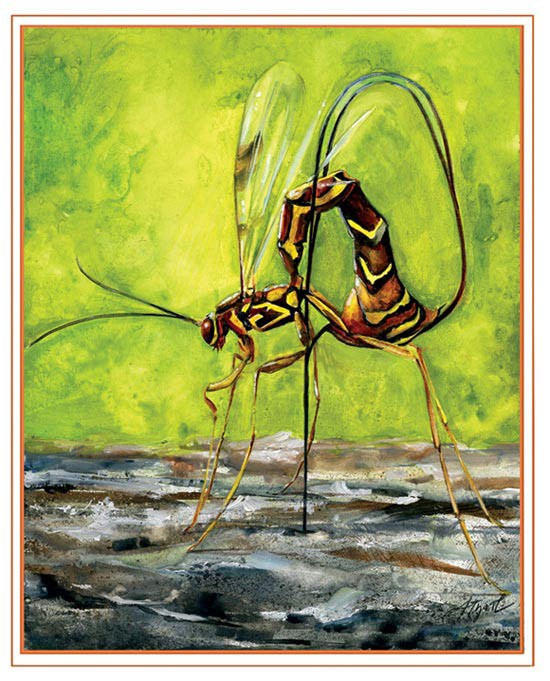
When an insect develops on a single host, and kills the host in the process, it is called a parasitoid. Parasites, on the other hand, tend to nibble on their hosts without killing them. And predators kill more than one of their prey items.
Because most parasitoids spend much of their lives buried within the bodies of their victims, they don’t attract a lot of attention. But they are abundant and serve an important role in natural ecosystems – especially in agriculture, where they influence or regulate the population density of many of their hosts.
When a parasitoid kills its host, it can indeed be a grisly business. Typically, an adult female parasitoid lays an egg on the surface of or into the body of a living larva of another insect. When the egg hatches, the parasitoid proceeds to systematically consume the host. Like a cat with a mouse, it keeps its victim alive as long as possible. Dead larvae rot quickly, and this ruins the meal. First the parasitoid eats the fat bodies of the larva, then the digestive organs, keeping the heart and central nervous system intact for as long as possible. Finally, these are consumed as well and the long-suffering victim dies, leaving an empty caterpillar shell in which the victorious insect may choose to pupate.
The slow death inflicted by parasitoids that attack other insects (and sometimes spiders) tested the concept of a benevolent God for 19th-century theologians who discussed this practice at length.
Even Darwin had trouble with the largest parasitoid family, as he wrote to Asa Gray in 1860: “I cannot persuade myself that a beneficent and omnipotent God would have designedly created the Ichneumonidae with the express intention of their feeding within the living bodies of Caterpillars…”
The female giant ichneumon wasp is a striking animal, two inches long, boldly patterned in brown, orange, and yellow. Her two- to four-inch long ovipositor with its two protective filaments looks like three long tails. Some parasitoids can choose to lay their eggs on a variety of host species, but giant ichneumon wasps need to find a larva of a pigeon horntail (Tremex columba), which is also a kind of wasp. Nothing else will do.
There is intense selective pressure on both of these insects to outwit the other. When a horntail female lays her egg in a tree, she includes both a fungus and a mucus secretion that promotes fungal growth, thus enabling her larva to burrow deeply into the wood. While this defensive strategy may once have given the horntail an advantage, the clever ichneumon soon figured out how to zero in on the very fungus that the horntail has enlisted. Once a female Megarhyssa arrives at the promising tree, she appears to use her antennae to sense the vibrations of her potential host.
She walks slowly over the bark, her antennae busily going back and forth, before drilling commences. Drilling might take half an hour, as the ovipositor is slowly pushed through up to 4 inches of solid wood.
The ichneumon ovipositor is incredibly slender, not much thicker than a horse hair, and the egg that passes though it is, by necessity, deformed into a slender, threadlike shape. But the process of finding a horntail, drilling a hole, and inserting an egg does not always result in a next ichneumon generation.
Other ichneumon wasps, of species that are unable to drill such holes themselves, may use Megarhyssa holes to insert their own eggs. When these hatch, the larvae destroy the Megarhyssa eggs and proceed to consume the horntail larva themselves.
An appealing host larva may have several parasitoid species competing for its nourishing tissues. In addition, many parasitoids have evolved to prey only on other parasitoids; these are called hyperparasitoids. And, amazingly, some hyperparasitoids are themselves attacked by parasitoids – making an extremely long food chain.
There is great variation in the behavior, shape, and size of insects who survive by consuming their brethren in this way. A tiny egg parasitoid in the wasp family Mymaridae, at one eightthousandth of an inch long, may be the world’s smallest insect.
It is thought that this lifestyle may have developed in the distant past from insects that consumed dead prey. Some entomologists believe that around 20 percent of all insect species now living are parasitoids. The insect order that includes wasps and bees has the greatest number, but there are many parasitoid flies as well, along with the occasional beetle or moth.


Discussion *